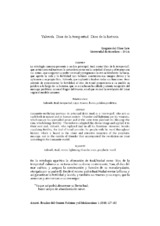Yahweh, Dios de la tempestad, Dios de la historia
Autor
Olmo Lete, Gregorio del
Editor
UCOPressFecha
2018Materia
YahwehBaal
Tempestad
Rayo
Trueno
Lluvia
Palabra profética
Storm
Lightning
Thunder
Rain
Prophetic word
METS:
Mostrar el registro METSPREMIS:
Mostrar el registro PREMISMetadatos
Mostrar el registro completo del ítemResumen
La mitología cananea presenta a su dios principal, Baal, como ‘dios de la tempestad’, que actúa como tal tanto en la naturaleza como en la sociedad. El rayo y el trueno son sus armas, que aseguran su poder sin rival y pregonan a la vez su bendición: la lluvia, que aporta la vida y la fertilidad. Los hebreos asumieron esa imagen divina y la aplicaron a su propio Dios, Yahweh, que suplantó a Baal en todas sus funciones. Pero además de proporcionar la fertilidad, el Dios de Israel proporciona a su pueblo su palabra a lo largo de su historia, que se escucha en la callada y atenta recepción del mensaje profético, no en el fragor del trueno, en el que resonó la revelación del Sinaí según el modelo cananeo. Canaanite mythology portrays its principal deity, Baal, as a ‘storm god’, who acts as such both in nature and in human society. Thunder and lightning are his weapons, which ensure his unrivalled power and at the same time proclaim his blessing: the rain, which brings fertility. The Hebrews adopted this divine image and applied it to their own God, Yahweh, who replaced Baal in all his functions. However, besides supplying fertility, the God of Israel provides his people with his word throughout history, which is heard in the silent and attentive reception of the prophetic message, not in the rumble of thunder that accompanied the revelation on Sinai according to the Canaanite model.

